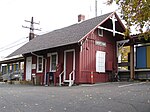Fairfield Swamp Fight
1637 in Connecticut1637 in the Thirteen ColoniesBattles in ConnecticutColonial American and Indian warsConflicts in 1637 ... and 6 more
Fairfield, ConnecticutHistory of Fairfield County, ConnecticutMassacres of Native AmericansMilitary history of the Thirteen ColoniesPequot WarPre-statehood history of Connecticut

The Fairfield Swamp Fight (also known as the Great Swamp Fight) was the last engagement of the Pequot War and marked defeat of the Pequot tribe in the war and the loss of their recognition as a political entity in the 17th century. The participants in the conflict were the Pequot and the English with their allied tribes (the Mohegan and Narragansett). The Fairfield Swamp Fight occurred July 13–14, 1637 in what is present-day Fairfield, Connecticut. The town of Fairfield was founded after the battle in 1639.
Excerpt from the Wikipedia article Fairfield Swamp Fight (License: CC BY-SA 3.0, Authors, Images).Fairfield Swamp Fight
Old Post Road,
Geographical coordinates (GPS) Address Nearby Places Show on map
Geographical coordinates (GPS)
| Latitude | Longitude |
|---|---|
| N 41.138333333333 ° | E -73.290277777778 ° |
Address
Great Swamp Fight - 1637
Old Post Road
06890
Connecticut, United States
Open on Google Maps







